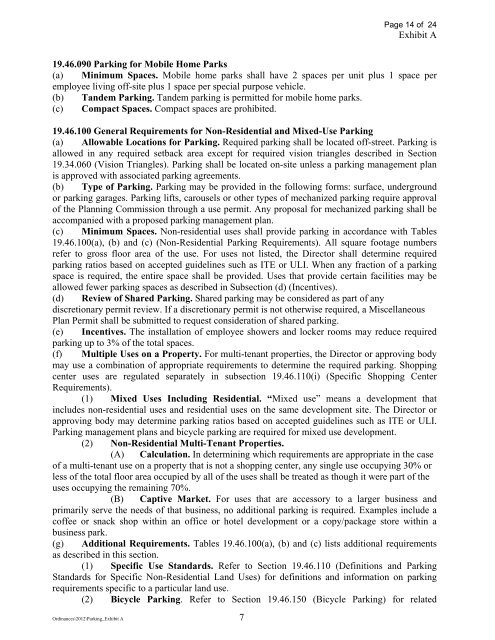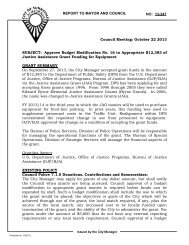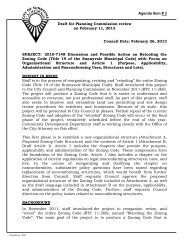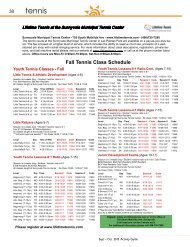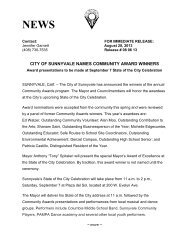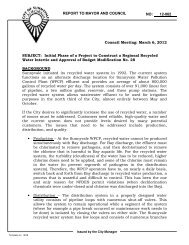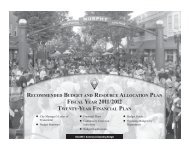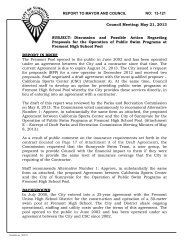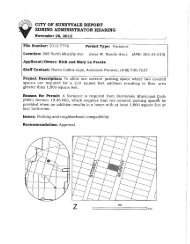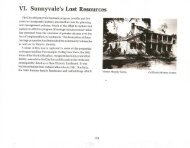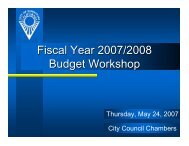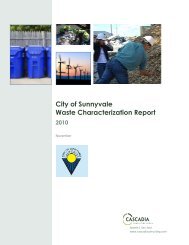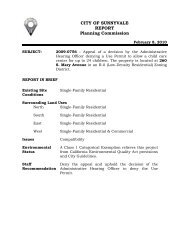12-294 - City of Sunnyvale - State of California
12-294 - City of Sunnyvale - State of California
12-294 - City of Sunnyvale - State of California
You also want an ePaper? Increase the reach of your titles
YUMPU automatically turns print PDFs into web optimized ePapers that Google loves.
Ordinances\20<strong>12</strong>\Parking_Exhibit A 7<br />
Page 14 <strong>of</strong> 24<br />
Exhibit A<br />
19.46.090 Parking for Mobile Home Parks<br />
(a) Minimum Spaces. Mobile home parks shall have 2 spaces per unit plus 1 space per<br />
employee living <strong>of</strong>f-site plus 1 space per special purpose vehicle.<br />
(b) Tandem Parking. Tandem parking is permitted for mobile home parks.<br />
(c) Compact Spaces. Compact spaces are prohibited.<br />
19.46.100 General Requirements for Non-Residential and Mixed-Use Parking<br />
(a) Allowable Locations for Parking. Required parking shall be located <strong>of</strong>f-street. Parking is<br />
allowed in any required setback area except for required vision triangles described in Section<br />
19.34.060 (Vision Triangles). Parking shall be located on-site unless a parking management plan<br />
is approved with associated parking agreements.<br />
(b) Type <strong>of</strong> Parking. Parking may be provided in the following forms: surface, underground<br />
or parking garages. Parking lifts, carousels or other types <strong>of</strong> mechanized parking require approval<br />
<strong>of</strong> the Planning Commission through a use permit. Any proposal for mechanized parking shall be<br />
accompanied with a proposed parking management plan.<br />
(c) Minimum Spaces. Non-residential uses shall provide parking in accordance with Tables<br />
19.46.100(a), (b) and (c) (Non-Residential Parking Requirements). All square footage numbers<br />
refer to gross floor area <strong>of</strong> the use. For uses not listed, the Director shall determine required<br />
parking ratios based on accepted guidelines such as ITE or ULI. When any fraction <strong>of</strong> a parking<br />
space is required, the entire space shall be provided. Uses that provide certain facilities may be<br />
allowed fewer parking spaces as described in Subsection (d) (Incentives).<br />
(d) Review <strong>of</strong> Shared Parking. Shared parking may be considered as part <strong>of</strong> any<br />
discretionary permit review. If a discretionary permit is not otherwise required, a Miscellaneous<br />
Plan Permit shall be submitted to request consideration <strong>of</strong> shared parking.<br />
(e) Incentives. The installation <strong>of</strong> employee showers and locker rooms may reduce required<br />
parking up to 3% <strong>of</strong> the total spaces.<br />
(f) Multiple Uses on a Property. For multi-tenant properties, the Director or approving body<br />
may use a combination <strong>of</strong> appropriate requirements to determine the required parking. Shopping<br />
center uses are regulated separately in subsection 19.46.110(i) (Specific Shopping Center<br />
Requirements).<br />
(1) Mixed Uses Including Residential. “Mixed use” means a development that<br />
includes non-residential uses and residential uses on the same development site. The Director or<br />
approving body may determine parking ratios based on accepted guidelines such as ITE or ULI.<br />
Parking management plans and bicycle parking are required for mixed use development.<br />
(2) Non-Residential Multi-Tenant Properties.<br />
(A) Calculation. In determining which requirements are appropriate in the case<br />
<strong>of</strong> a multi-tenant use on a property that is not a shopping center, any single use occupying 30% or<br />
less <strong>of</strong> the total floor area occupied by all <strong>of</strong> the uses shall be treated as though it were part <strong>of</strong> the<br />
uses occupying the remaining 70%.<br />
(B) Captive Market. For uses that are accessory to a larger business and<br />
primarily serve the needs <strong>of</strong> that business, no additional parking is required. Examples include a<br />
c<strong>of</strong>fee or snack shop within an <strong>of</strong>fice or hotel development or a copy/package store within a<br />
business park.<br />
(g) Additional Requirements. Tables 19.46.100(a), (b) and (c) lists additional requirements<br />
as described in this section.<br />
(1) Specific Use Standards. Refer to Section 19.46.110 (Definitions and Parking<br />
Standards for Specific Non-Residential Land Uses) for definitions and information on parking<br />
requirements specific to a particular land use.<br />
(2) Bicycle Parking. Refer to Section 19.46.150 (Bicycle Parking) for related


